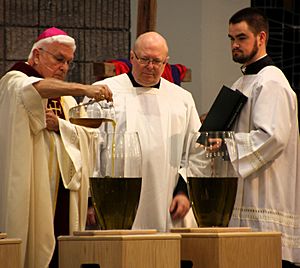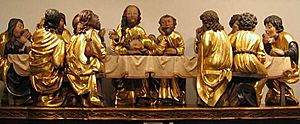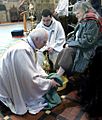Maundy Thursday facts for kids
Maundy Thursday is a special Christian holiday. It's also known as Holy Thursday. This day happens on the Thursday right before Easter. It's a time when Christians remember two very important events from the Bible. These are the washing of feet (also called the Maundy) and the Last Supper of Jesus Christ with his Apostles. These stories are found in the Canonical gospels. Maundy Thursday is the fifth day of Holy Week, coming after Holy Wednesday and before Good Friday.
The date for Maundy Thursday changes each year, falling between March 19 and April 22. This depends on which calendar, Gregorian or Julian calendar, a church uses. Many Eastern churches use the Julian calendar. So, for them, this holiday might be between April 1 and May 5 on the more common Gregorian calendar. The evening service on Maundy Thursday begins the Paschal Triduum. This is a three-day period that remembers Jesus's suffering, death, and coming back to life. The Triduum includes Good Friday, Holy Saturday, and ends on Easter Sunday evening. The main service usually happens in the evening. This is because, in Jewish tradition, a new day begins at sunset. The Last Supper itself was part of the Passover feast.
Contents
What are the different names for this day?
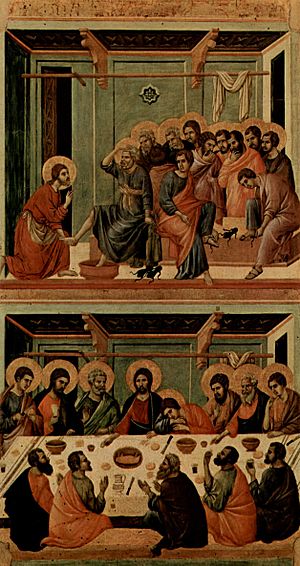
You might hear this day called "Maundy Thursday" or "Holy Thursday." The name used often depends on where you live and which Christian group you belong to. For example, in England, "Maundy Thursday" is common. But in Ireland or Scotland, people might not use that name as much in church.
Different churches also have their preferred names:
- The Anglican Church uses "Maundy Thursday" in its official prayer book.
- The Roman Catholic Church often uses "Holy Thursday" in its official English books.
- The United Methodist Church uses "Holy Thursday" in some books, but also "Maundy Thursday" in others.
- Many other Christian groups, like Lutherans and Reformed Christians, use both names.
- The Eastern Orthodox Church calls it "Great and Holy Thursday" or "Holy Thursday."
- The Coptic Orthodox Church uses "Maundy Thursday" and "Covenant Thursday."
- In the Maronite Church and Syriac Orthodox Church, it's known as "Thursday of Mysteries."
"Maundy Thursday" is the official name in the laws of England and the Philippines.
This day was also once called Shere Thursday. The word shere means "clean" or "bright." This name might refer to cleaning things, or to churches changing their liturgical colors from dark to bright. It could also be because people used to shave their beards on this day. This name is similar to words used in Scandinavian countries, like "Skärtorsdag" in Swedish, which also means "wash."
Where does the name "Maundy" come from?
Most experts believe the word "Maundy" comes from the Latin word mandatum. This word means "commandment." It's the first word of a special phrase Jesus said in the Gospel of John 13:34: "A new commandment I give unto you, That ye love one another; as I have loved you." Jesus said this after he washed his Apostles' feet. This phrase helps explain why he washed their feet. In many churches, especially the Catholic Church, this phrase is sung during the foot washing ceremony. A priest or bishop washes the feet of others, just as Jesus did.
However, some people have another idea. They think "Maundy" might come from "maundsor baskets" or "maundy purses." These were baskets or purses filled with gifts given to the poor by the King of England on this day. So, "maund" could be linked to the Latin word mendicare, which means "to beg." This idea suggests the name comes from the act of giving to those who beg.
What happens during services?
In Western Christian Churches
A special event on Holy Thursday is the Chrism Mass. This service usually takes place in the main church of a diocese, called a cathedral. During this Mass, the bishop blesses special holy oils. These include the chrism (used for confirmation), the oil of the sick, and the oil of catechumens (used for baptism). These oils are then used later, especially at the Easter Vigil on Holy Saturday, for people joining the church.
The Washing of the Feet is a very old tradition. Many Christian churches do this, including Armenian, Ethiopian, Eastern Orthodox, Eastern Catholic, German Baptist, Mennonite, and Roman Catholic churches. It's also becoming more common in Anglican, Lutheran, Methodist, and Presbyterian churches.
In the Catholic Church and some Anglican churches, the Mass of the Lord's Supper begins with the usual prayers. When the "Gloria" is sung, bells are rung. After this, the bells stay silent until the Easter Vigil. After the sermon, the washing of feet may happen. At the end of the service, the Blessed Sacrament (the consecrated bread) is taken in a procession to a special place. Then, the main altar and other altars in the church are stripped bare. This prepares the church for the serious Good Friday service. Other Christian groups, like Lutherans and Methodists, also strip their altars.
In Eastern Christian Churches
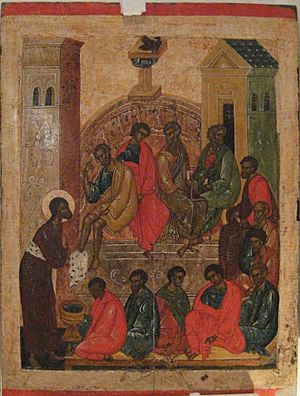
In the Eastern Orthodox Church, the mood of Lent changes on this day. The church liturgical colours become more festive, often white. On this day, people are allowed to have wine and oil, which is a small break from the Lenten fast.
The main service is called Vespers combined with the Liturgy of St. Basil the Great. During this service, a part of the Bible from John (13:31-18:1) is read. This is known as the "Gospel of the Testament." Many regular hymns are replaced with a special song that says:
Of Thy Mystical Supper, O Son of God, accept me today as a communicant; for I will not speak of Thy Mystery to Thine enemies, neither will I give Thee a kiss like Judas. But like the Thief will I confess Thee: Remember me, O Lord, in Thy Kingdom.
If more consecrated bread is needed for sick people later, it is prepared on this day. It is then dried until Holy Saturday and stored in a special container.
In larger churches and monasteries, the Washing of Feet ceremony is usually performed.
Sometimes, if more chrism (holy oil) is needed, it is prepared and blessed by the church leaders on this day.
In the evening, after the service, all the church decorations and clothes are changed to black or other dark Lenten colors. This shows that the time of Jesus's suffering (the Passion) is beginning.
From Holy and Great Thursday until after Thomas Sunday, special prayers for the dead are not allowed.
Local customs
- In Greece, a special prayer service called Unction is sometimes done on Holy Wednesday. This helps people prepare for Holy Communion on Great Thursday and Easter.
- In Greek tradition, there's a procession during the service of the Twelve Passion Gospels. A large cross with the body of Christ is carried through the church. Lights are turned off, bells ring slowly, and people bow down. The cross is then placed in front of the church doors.
- In some Slavic traditions, a smaller procession happens. An icon of Christ's crucifixion is placed in the center of the church.
Customs and names from around the world
- In the United Kingdom, the Monarch (like Queen Elizabeth II) gives out special "alms" (gifts) to deserving older citizens. They get special coins called Maundy money in red and white purses. This tradition goes back to King Edward I. The red purse has regular money, and the white purse has special coins, one for each year of the Monarch's age. Until King James II, the Monarch would also wash the feet of these people. There's even an old drawing of Queen Elizabeth I washing feet on Maundy Thursday.
- In German-speaking countries, the day is often called Gründonnerstag. This can mean "mourning Thursday" or "green Thursday." Other names are Hoher, Heiliger, and Weißer Donnerstag (High, Holy, and White Thursday). "White" refers to the white liturgical colour used on this day.
- In the Czech Republic and Slovakia, it's called Zelený čtvrtek or Zelený štvrtok, meaning "Green Thursday." Church bells become silent until Holy Saturday (called "White Saturday") because people say "they have flown to Rome." Instead, children walk around making noise with wooden rattles, and people give them money.
- This tradition of silent bells is also found in Luxembourg. Children use wooden rattles to call people to church.
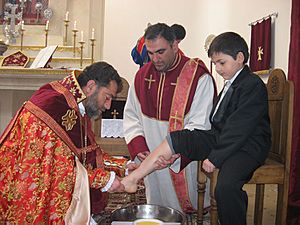
- In Malta, Holy Thursday is Ħamis ix-Xirka (Communion Thursday). People often visit seven churches, a tradition called is-seba' visti.
- In Welsh, Maundy Thursday is Dydd Iau Cablyd.
- In Denmark and Norway, Maundy Thursday (skærtorsdag/skjærtorsdag) is a public holiday.
- In Sweden, Maundy Thursday (skärtorsdagen) is linked to old stories about witches. Young children sometimes dress up as witches and go door-to-door for coins or candy for Easter eggs.
- In Bulgaria, it's Veliki Chetvurtuk (Great Thursday). This is when people traditionally color their Easter eggs and do chores to prepare for the upcoming holidays.
- In Kerala, India, where many Saint Thomas Christians live, this day is called Pesaha. This word comes from the Aramaic or Hebrew word for Passover. It remembers Jesus's Last Supper during Passover. This is a public holiday in Kerala. People traditionally eat Pesaha appam (unleavened bread) and Pesaha milk after church services.
- In the Philippines, the day is officially Huwebes Santo or "Maundy Thursday." Most businesses close during the Paschal Triduum. TV and radio stations either go off-air or have special programming.
- If statues and crucifixes were covered during the last two weeks of Lent, their covers might be changed to white instead of purple for Holy Thursday.
Is it a public holiday?
Maundy Thursday is a public holiday in Denmark, Iceland, Norway, Spain, Paraguay, Colombia, Costa Rica, Venezuela, and The Philippines.
Visiting Seven Churches
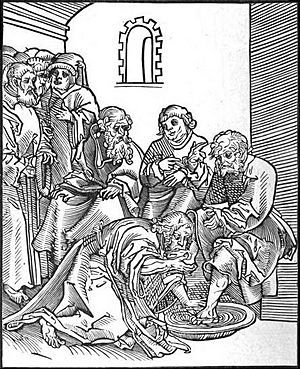
The tradition of visiting seven churches on Holy Thursday is a very old practice. It probably started in Rome.
- In the Philippines, this tradition is called Visita Iglesia (Spanish for "church visit"). People visit one, seven, or fourteen churches to pray, often saying the Stations of the Cross. This is mostly an urban custom because churches are closer together in cities. The original idea was to visit the Blessed Sacrament in the Altar of Repose on Maundy Thursday evening.
- In many countries in Latin America, people also visit seven churches on Holy Thursday night.
- In Singapore, visiting churches happens after the evening Mass. People say the Lord's Prayer, Ave Maria, and the Gloria Patri seven times at each church. There's a festive atmosphere, with food and drinks sold. Catholic families often have a "Last Supper" meal before the fast on Good Friday.
- In India, the custom is to visit fourteen churches, one for each Station of the Cross. This is usually done on Maundy Thursday evening or on Good Friday morning. Families often do this together, sometimes fasting during the visits.
Images for kids
-
A Maundy ceremony in a Church in Wales church during a Maundy Thursday service of worship.
-
Pesaha appam (unleavened bread) and Pesaha milk made during Maundy Thursday by Saint Thomas Christians of Kerala, India.
See also
 In Spanish: Jueves Santo para niños
In Spanish: Jueves Santo para niños


